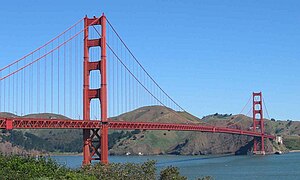Transportation in California

California's transportation system is dynamic and usually functional, however, in a state with over 30 million people, rapid population expansion, and diverse terrain and weather, that system is under pressure to stay ahead of population growth and transportation needs.
Interstates and highways

Interstate Highways
U.S. Routes
California is known for its car culture, and its residents typically take to the roads for their commutes, errands, and vacations, giving California's cities a reputation for severe traffic congestion.
California's vast terrain is connected by an extensive system of freeways, expressways, and highways, all maintained by Caltrans and patrolled by the California Highway Patrol, except for the numbered expressways in Santa Clara County which were built and maintained by the county itself. The main north-south arteries are U.S. Route 101, which runs close to the coast from the state's border with Oregon, across the Golden Gate Bridge, to downtown Los Angeles, and Interstate 5, which runs inland from the Oregon to Mexico borders, bisecting the entire state. In addition, a major north-south artery is State Highway 99, which runs from near Red Bluff to near Bakersfield; Highway 99 is largely parallel to Interstate 5, and connects the Central Valley cities not connected by Interstate 5. Almost all California highways are non-toll roads; however, there are a few toll roads, and most major bridges have toll plazas.
Perhaps it is a testament to California's sheer size that although it has one of the most extensive freeway systems in the United States, it contains many of the largest cities in the United States not served by an Interstate Highway, including the two largest, Fresno (pop. 471,479) and Bakersfield (pop. 247,057).[1] These cities, along with Modesto and Visalia, are passed by as Interstate 5 veers west to avoid the congestion of the populated eastern side of the Central Valley as it connects Sacramento and Los Angeles.[2]
The state's most famous highway bridge is the Golden Gate Bridge, though there are major bridges elsewhere at Sacramento, Los Angeles, and San Diego.
Air travel
Los Angeles International Airport and San Francisco International Airport are major hubs for trans-Pacific and transcontinental traffic. There are about a dozen important commercial airports and many more general aviation airports throughout the state's 58 counties.
Seaports and harbors
California also has several important seaports. The giant seaport complex formed by the Port of Los Angeles and the Port of Long Beach in Southern California is the largest in the country and responsible for handling about a fourth of all container cargo traffic in the United States. The Port of Oakland handles most of the ocean containers passing through Northern California. The Port of Redwood City is a world-ranked port and the only deepwater port in South San Francisco Bay.
Rail and bus travel
Intercity rail travel is provided by Amtrak California, which manages the three busiest intercity rail lines in the US outside the Northeast Corridor. Integrated subway and light rail networks are found in Los Angeles (Metro Rail) and San Francisco (BART and MUNI Metro). Light rail systems are also found in San Jose (VTA), San Diego (San Diego Trolley), Sacramento (RT Light Rail), and Northern San Diego County (Sprinter). Furthermore, commuter rail networks serve the San Francisco Bay Area (ACE), Greater Los Angeles (Metrolink), and San Diego County (Coaster). Nearly all counties operate bus lines, and many cities operate their own bus lines as well. Intercity bus travel is provided by Greyhound, Amtrak Thruway Coach, Xe Đò Hoàng Transportation [1], and California Shuttle Bus [2].
Future issues
The rapidly growing population of the state is straining all of its transportation networks.[citation needed] A regularly recurring issue in California politics is whether the state should continue to aggressively expand its freeway network or concentrate on improving mass transit networks in urban areas.
The California High Speed Rail Authority was created in 1996 by the state to implement an extensive 700 mile (1127 km) rail system. Voters approved Proposition 1A in November 2008, approving a $9 billion state bond. The system would provide a TGV-style high-speed link between the state's four major metropolitan areas, and would allow travel between Los Angeles' Union Station and the San Francisco Transbay Terminal in two and a half hours.
Only 10% of California's residents travel by public transport. It is mainly a car culture.
